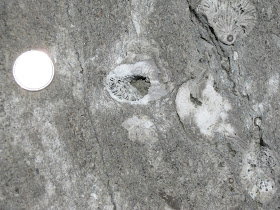I'm starting to prep for a field program in Sierra Leone again and have come to the thorny problem of photography.
Earlier in my career I used to drag around a Nikkormat, with one wide-angle lens, one 50 mm macro, and a telephoto lens.
Why, there it is, freshly exhumed from the closet where it spent the last ten years or so. Yes, lately I have been using digital.
The trouble is, on the next trip, the macro capabilities are going to be important. And unfortunately, the digital cameras I have offer nothing in comparison to the macro capabilities of above camera, which (with the appropriate lens) can produces an image on the film which is larger than the original object (examples follow).
Earlier in my career I used to drag around a Nikkormat, with one wide-angle lens, one 50 mm macro, and a telephoto lens.
Why, there it is, freshly exhumed from the closet where it spent the last ten years or so. Yes, lately I have been using digital.
The trouble is, on the next trip, the macro capabilities are going to be important. And unfortunately, the digital cameras I have offer nothing in comparison to the macro capabilities of above camera, which (with the appropriate lens) can produces an image on the film which is larger than the original object (examples follow).
All of the above were captured on slide film, and then scanned in at home. The coin used for scale is the now-extinct Canadian penny. Scale in the bottom photo is a lens cap. From top to bottom: 1) crinoid ossicle in Silurian dolostone; 2) branching bryozoan (and base of crinoid or blastoid calyx beside penny) in Ordovician shales of the Middle Trenton, Canada Cement quarry; 3) a variety of fossils from the Middle Trenton shales; 4) pyrite replacement on brachiopods, St. Mary's Cement quarry; 5) graphic intergrowth from somewhere in Finland; 6) Precambrian broken algal mat, Rae River, NWT; 7) Gold grain under worker's fingernail, coastal Ghana. All taken more than 15 years ago (scanned much more recently).
Meanwhile, with my present camera, the best I have been able to manage are pictures like these:
Canadian nickel used for a scale. From top to bottom: 1) corals in Silurian dolostone; 2) calcite crystals in a a vug; 3) shells screened off of marine sands, coastal Ghana (mesh size 4 mm, I think).
For the quality of the image, the film camera is better than anything I can afford in the digital realm--but it is bulky, and film processing isn't as easy to come by as it used to be. Especially for slide film, because prints would never have turned out as well. And in SL.
The great advantage of digital is that at least you know whether or not the picture turns out before you leave the field locality.
At this point I am looking at options. I can borrow a camera that is much better than what I have now, but still not as good for macro. I can buy a newer model, but not a DSLR.











Buy a Nex (used or entry level), buy a nik to nex adapter from China via Amazon, and put your good old trusty Micro Nikkor 55mm f/3.5 or what have you on it! The Nex has Live View, so you see what you will get before you press the button (and you can press many times) and it is small(er) setup... So you don't need to buy a new lens and you know what results you can expect.
ReplyDeleteThis one is not quite macro, but with a film day macro lens (also have and like the Nikkor but no example online):
http://clemenslee.blogspot.com/2013/07/fear-fork.html
Clemens